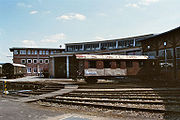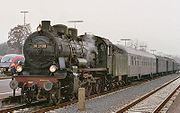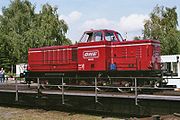
South German Railway Museum
Encyclopedia

Railway museum
A railway museum is a museum that explores the history of all aspects of rail related transportation, including: locomotives , railway cars, trams, and railway signalling equipment.See List of railway museums...
at Heilbronn
Heilbronn
Heilbronn is a city in northern Baden-Württemberg, Germany. It is completely surrounded by Heilbronn County and with approximately 123.000 residents, it is the sixth-largest city in the state....
in the state of Baden-Württemberg
Baden-Württemberg
Baden-Württemberg is one of the 16 states of Germany. Baden-Württemberg is in the southwestern part of the country to the east of the Upper Rhine, and is the third largest in both area and population of Germany's sixteen states, with an area of and 10.7 million inhabitants...
in southwestern Germany. It was founded in 1998.
Aims
The museum has the following aims:1. To preserve the site of the former Heilbronn locomotive depot, part of which is under historic building protection.
2. To preserve historical railway vehicles and their associated infrastructure and to display them to the general public.
The members of the board of trustees work for the museum as volunteers.
Site and Description of the Museums

Deutsche Bundesbahn
The Deutsche Bundesbahn or DB was formed as the state railway of the newly established Federal Republic of Germany on September 7, 1949 as a successor of the Deutsche Reichsbahn-Gesellschaft '...
locomotive depot at Heilbronn
Heilbronn
Heilbronn is a city in northern Baden-Württemberg, Germany. It is completely surrounded by Heilbronn County and with approximately 123.000 residents, it is the sixth-largest city in the state....
in the Böckingen district of the town. The depot was opened in 1893 by the Royal Württemberg State Railways
Royal Württemberg State Railways
The Royal Württemberg State Railways were the state railways of the Kingdom of Württemberg between 1843 and 1920...
(Königlich Württembergische Staats-Eisenbahnen or K.W.St.E.), and owned in succession by the Deutsche Reichsbahn
Deutsche Reichsbahn
Deutsche Reichsbahn was the name of the following two companies:* Deutsche Reichsbahn, the German Imperial Railways during the Weimar Republic, the Third Reich and the immediate aftermath...
, Deutsche Bundesbahn
Deutsche Bundesbahn
The Deutsche Bundesbahn or DB was formed as the state railway of the newly established Federal Republic of Germany on September 7, 1949 as a successor of the Deutsche Reichsbahn-Gesellschaft '...
and Deutsche Bahn
Deutsche Bahn
Deutsche Bahn AG is the German national railway company, a private joint stock company . Headquartered in Berlin, it came into existence in 1994 as the successor to the former state railways of Germany, the Deutsche Bundesbahn of West Germany and the Deutsche Reichsbahn of East Germany...
, before being taken over in 2000 by the museum's board of trustees. The museum has about 80 exhibits (wagons and locomotives). On the site is a locomotive roundhouse
Roundhouse
A roundhouse is a building used by railroads for servicing locomotives. Roundhouses are large, circular or semicircular structures that were traditionally located surrounding or adjacent to turntables...
with a working turntable, as well as a large wagon shed. Steam and diesel engines can be serviced and looked after.
Members of the museum restore locomotives and wagons from the period 1895 to the 1950s. In addition, the roundhouse opened in 1893 is being refurbished. This is the only remaining roundhouse from the time of the Royal Württemberg State Railways that can still be seen in its original state.
Museum Vehicles
Here is a brief overview of the locomotives and wagons owned by the museum. A detailed description of these exhibits may be found on the museum website.Steam Locomotives

- Steam locomotive Prussian P 8Prussian P 8The Prussian Class P 8 steam locomotive of the Prussian state railways was built from 1906 onwards by the Berliner Maschinenbau and the Linke-Hofmann factory in Breslau by Robert Garbe...
- Steam locomotive DRG Class 01.10DRG Class 01.10The locomotives of DRB Class 01.10 were standard locomotives used for express train services by the Deutsche Reichsbahn...
- Steam locomotive DB Class 23DB Class 23The steam locomotives of Class 23 were German passenger train locomotives developed in the 1950s for the Deutsche Bundesbahn. They had a 2-6-2 wheel arrangement and were equipped with Class 2'2' T 31 tenders...
- Steam locomotive DRG Class 44DRG Class 44The Class 44 was a ten-coupled, heavy goods train steam locomotive built for the Deutsche Reichsbahn as a standard steam engine class . Its sub-class was G 56.20 and it had triple cylinders...
- Steam locomotive DRB Class 50DRB Class 50Because the Deutsche Bundesbahn had sufficient goods train locomotives, they could quickly phase out the DRB Class 52 engines, so that the ageing boilers on the Class 50s could be replaced by those of the Class 52s. Even the 'bathtub' tender of the Kriegslokomotiven was used by the 50s amongst...
- Steam locomotive DR Class 52.80DR Class 52.80The Rekolokomotives of DR Class 52.80 first appeared in 1960 in service with the Deutsche Reichsbahn in East Germany as extensive rebuilds of the wartime locomotives or Kriegslokomotiven of DRB Class 52...
- Steam locomotive DRG Class 64DRG Class 64The Deutsche Reichsbahn had a standard passenger train tank engine with a wheel arrangement of 1'C1' or 2-6-2 and a low axle load, which was designated in their classification system as the DRG Class 64 . The Class 64 was developed from 1926 onwards and it was built between 1928 and 1940...
"Bubikopf" - Steam locomotive DRG Class 80DRG Class 80The Class 80 tank engines were German standard locomotives with the Deutsche Reichsbahn. They were intended to replace the aging, rickety state railway line engines performing shunting duties in their dotage at large stations.- History :...
- Steam locomotive DRG Class 86DRG Class 86The DRG Class 86 was a standard goods train tank locomotive with the Deutsche Reichsbahn-Gesellschaft. It was intended for duties on branch lines and was delivered by almost all the locomotive building firms working for the Reichsbahn...
- Express locomotive (French) SNCF Class 231 K
- Several industrial locomotives.
The star of the show is undoubtedly the Prussian P 8
Prussian P 8
The Prussian Class P 8 steam locomotive of the Prussian state railways was built from 1906 onwards by the Berliner Maschinenbau and the Linke-Hofmann factory in Breslau by Robert Garbe...
steam locomotive, number 38 3199, bought back from Rumania and restored to working condition. In addition, numbers 86 457
DRG Class 86
The DRG Class 86 was a standard goods train tank locomotive with the Deutsche Reichsbahn-Gesellschaft. It was intended for duties on branch lines and was delivered by almost all the locomotive building firms working for the Reichsbahn...
and 23 105
DB Class 23
The steam locomotives of Class 23 were German passenger train locomotives developed in the 1950s for the Deutsche Bundesbahn. They had a 2-6-2 wheel arrangement and were equipped with Class 2'2' T 31 tenders...
, which were victims of the great fire at Nuremberg-Gostenhof on 17 October 2005, are housed here.
Only the carcasses remain on many of the other valuable steam locomotives, but they are being gradually rebuilt into visual exhibits.
As well as the SEH museum's own locomotives, express train steam engines belonging to the Ulm Railway Friends are also stationed here.
Diesel Locomotives

DB class V 200
DB Class V 200.0 was one of the first diesel-hydraulic express locomotives of the German Deutsche Bundesbahn and - as Am 4/4 - of the SBB-CFF-FFS in Switzerland.-DB Service:...
(later Class 221), DB Class V 60
DB Class V 60
The DB Class V 60 is a German diesel locomotive operated by the Deutsche Bundesbahn and later, the Deutsche Bahn AG , which is used particularly for shunting duties, but also for hauling light goods trains. Seventeen locomotives were bought used by the Norwegian State Railways and designated NSB...
(later Class 260) and a MaK 800 D, which is similar to the DB Class V 65
DB Class V 65
The DB Class V 65 locomotives were German, eight-wheeled, rod-coupled diesel locomotives operated by Deutsche Bundesbahn intended for light railway services and medium-heavy shunting duties...
(later Class 265). The robust MaK
Mak
Mak is a Chinese surname. It is commonly transliterated as Mak in Hong Kong, based on the Cantonese pronunciation of the Chinese character; and is commonly transliterated as Mai in China, based on the Mandarin pronunciation. Other transliterations of the surname include Mack, Mark, Mac, and Mach...
, side-rod driven locomotive is operational and is used for transportation and industrial railway duties across the length and breadth of Germany.
Electric Locomotives
The SEH also has a DB Class E 50 and a DRG Class E 63 locomotive in its care and protection.Wagons
There is a collection of valuable PrussianPrussian state railways
The term Prussian state railways encompasses those railway organisations that were owned or managed by the State of Prussia...
and Saxon
Royal Saxon State Railways
The Royal Saxon State Railways were the state-owned railways operating in the Kingdom of Saxony from 1869 to 1918...
passenger coaches, that have still to be refurbished because, before they had been bought by the SEH, they had stood in the open for many years and fell into disrepair as a result. A lot of time and money will be required to restore them.
In the wagon shed a historical saloon coach belonging to the last crown prince of Prussia is on display.
Opening Times and Annual Events
The museum is open to visitors on weekends and public holidays between March and October. Larger events include the steam days in May and the steam engine festival in September that is also combined with a meeting of I-gauge model railway enthusiasts. At the latter, many working layouts and modules are displayed or presented and there are also I-gauge items for sale.External links
- SEH museum website with detailed information about opening times and events, as well as all the locomotives and wagons.
- Private website about the SEH by a member of the museum
- There is an English-language discussion forum at Railways of Germany

